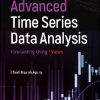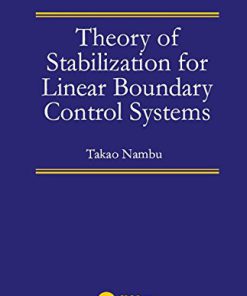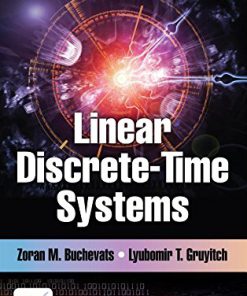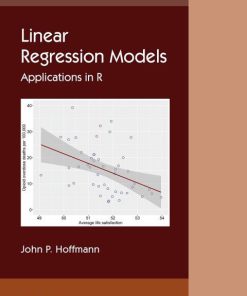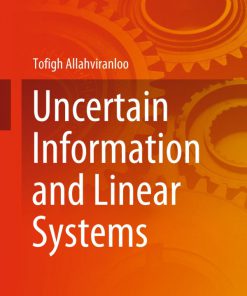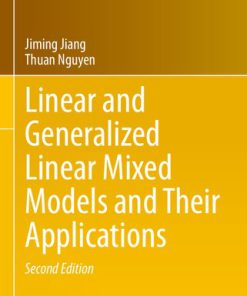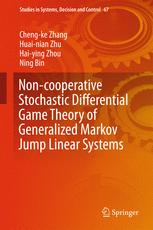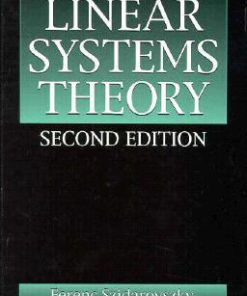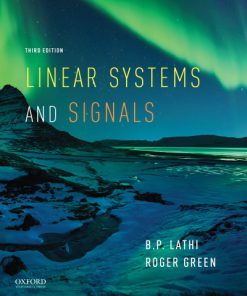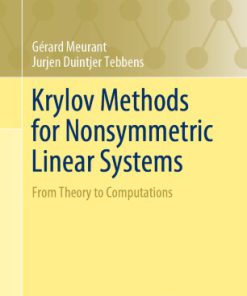Linear Systems Theory 2nd Edition by João Hespanha 140089008X 9781400890088
$50.00 Original price was: $50.00.$25.00Current price is: $25.00.
Linear Systems Theory 2nd Edition by João P. Hespanha – Ebook PDF Instant Download/DeliveryISBN: 140089008X, 9781400890088
Full download Linear Systems Theory 2nd Edition after payment.

Product details:
ISBN-10 : 140089008X
ISBN-13 : 9781400890088
Author: João P. Hespanha
A fully updated textbook on linear systems theory Linear systems theory is the cornerstone of control theory and a well-established discipline that focuses on linear differential equations from the perspective of control and estimation. This updated second edition of Linear Systems Theory covers the subject’s key topics in a unique lecture-style format, making the book easy to use for instructors and students. João Hespanha looks at system representation, stability, controllability and state feedback, observability and state estimation, and realization theory. He provides the background for advanced modern control design techniques and feedback linearization and examines advanced foundational topics, such as multivariable poles and zeros and LQG/LQR. The textbook presents only the most essential mathematical derivations and places comments, discussion, and terminology in sidebars so that readers can follow the core material easily and without distraction. Annotated proofs with sidebars explain the techniques of proof construction, including contradiction, contraposition, cycles of implications to prove equivalence, and the difference between necessity and sufficiency. Annotated theoretical developments also use sidebars to discuss relevant commands available in MATLAB, allowing students to understand these tools. This second edition contains a large number of new practice exercises with solutions. Based on typical problems, these exercises guide students to succinct and precise answers, helping to clarify issues and consolidate knowledge. The book’s balanced chapters can each be covered in approximately two hours of lecture time, simplifying course planning and student review. Easy-to-use textbook in unique lecture-style format Sidebars explain topics in further detail Annotated proofs and discussions of MATLAB commands Balanced chapters can each be taught in two hours of course lecture New practice exercises with solutions included
Linear Systems Theory 2nd table of contents:
I SYSTEM REPRESENTATION
1 STATE-SPACE LINEAR SYSTEMS
1.1 State-Space Linear Systems
1.2 Block Diagrams
1.3 Exercises
2 LINEARIZATION
2.1 State-Space Nonlinear Systems
2.2 Local Linearization Around an Equilibrium Point
2.3 Local Linearization Around a Trajectory
2.4 Feedback Linearization
2.5 Practice Exercises
2.6 Exercises
3 CAUSALITY, TIME INVARIANCE, AND LINEARITY
3.1 Basic Properties of LTV/LTI Systems
3.2 Characterization of All Outputs to a Given Input
3.3 Impulse Response
3.4 Laplace and Ƶ Transforms (Review)
3.5 Transfer Function
3.6 Discrete-Time Case
3.7 Additional Notes
3.8 Exercises
4 IMPULSE RESPONSE AND TRANSFER FUNCTION OF STATE-SPACE SYSTEMS
4.1 Impulse Response and Transfer Function for LTI Systems
4.2 Discrete-Time Case
4.3 Elementary Realization Theory
4.4 Equivalent State-Space Systems
4.5 LTI Systems in MATLAB®
4.6 Practice Exercises
4.7 Exercises
5 SOLUTIONS TO LTV SYSTEMS
5.1 Solution to Homogeneous Linear Systems
5.2 Solution to Nonhomogeneous Linear Systems
5.3 Discrete-Time Case
5.4 Practice Exercises
5.5 Exercises
6 SOLUTIONS TO LTI SYSTEMS
6.1 Matrix Exponential
6.2 Properties of the Matrix Exponential
6.3 Computation of Matrix Exponentials Using Laplace Transforms
6.4 The Importance of the Characteristic Polynomial
6.5 Discrete-Time Case
6.6 Symbolic Computations in MATLAB®
6.7 Practice Exercises
6.8 Exercises
7 SOLUTIONS TO LTI SYSTEMS: THE JORDAN NORMAL FORM
7.1 Jordan Normal Form
7.2 Computation of Matrix Powers using the Jordan Normal Form
7.3 Computation of Matrix Exponentials using the Jordan Normal Form
7.4 Eigenvalues with Multiplicity Larger than 1
7.5 Practice Exercise
7.6 Exercises
II STABILITY
8 INTERNAL OR LYAPUNOV STABILITY
8.1 Lyapunov Stability
8.2 Vector and Matrix Norms (Review)
8.3 Eigenvalue Conditions for Lyapunov Stability
8.4 Positive-Definite Matrices (Review)
8.5 Lyapunov Stability Theorem
8.6 Discrete-Time Case
8.7 Stability of Locally Linearized Systems
8.8 Stability Tests with MATLAB®
8.9 Practice Exercises
8.10 Exercises
9 INPUT-OUTPUT STABILITY
9.1 Bounded-Input, Bounded-Output Stability
9.2 Time Domain Conditions for BIBO Stability
9.3 Frequency Domain Conditions for BIBO Stability
9.4 BIBO versus Lyapunov Stability
9.5 Discrete-Time Case
9.6 Practice Exercises
9.7 Exercises
10 PREVIEW OF OPTIMAL CONTROL
10.1 The Linear Quadratic Regulator Problem
10.2 Feedback Invariants
10.3 Feedback Invariants in Optimal Control
10.4 Optimal State Feedback
10.5 LQR with MATLAB®
10.6 Practice Exercise
10.7 Exercise
III CONTROLLABILITY AND STATE FEEDBACK
11 CONTROLLABLE AND REACHABLE SUBSPACES
11.1 Controllable and Reachable Subspaces
11.2 Physical Examples and System Interconnections
11.3 Fundamental Theorem of Linear Equations (Review)
11.4 Reachability and Controllability Gramians
11.5 Open-Loop Minimum-Energy Control
11.6 Controllability Matrix (LTI)
11.7 Discrete-Time Case
11.8 MATLAB® Commands
11.9 Practice Exercise
11.10 Exercises
12 CONTROLLABLE SYSTEMS
12.1 Controllable Systems
12.2 Eigenvector Test for Controllability
12.3 Lyapunov Test for Controllability
12.4 Feedback Stabilization Based on the Lyapunov Test
12.5 Eigenvalue Assignment
12.6 Practice Exercises
12.7 Exercises
13 CONTROLLABLE DECOMPOSITIONS
13.1 Invariance with Respect to Similarity Transformations
13.2 Controllable Decomposition
13.3 Block Diagram Interpretation
13.4 Transfer Function
13.5 MATLAB® Commands
13.6 Exercise
14 STABILIZABILITY
14.1 Stabilizable System
14.2 Eigenvector Test for Stabilizability
14.3 Popov-Belevitch-Hautus (PBH) Test for Stabilizability
14.4 Lyapunov Test for Stabilizability
14.5 Feedback Stabilization Based on the Lyapunov Test
14.6 MATLAB® Commands
14.7 Exercises
IV OBSERVABILITY AND OUTPUT FEEDBACK
15 OBSERVABILITY
15.1 Motivation: Output Feedback
15.2 Unobservable Subspace
15.3 Unconstructible Subspace
15.4 Physical Examples
15.5 Observability and Constructibility Gramians
15.6 Gramian-Based Reconstruction
15.7 Discrete-Time Case
15.8 Duality for LTI Systems
15.9 Observability Tests
15.10 MATLAB® Commands
15.11 Practice Exercises
15.12 Exercises
16 OUTPUT FEEDBACK
16.1 Observable Decomposition
16.2 Kalman Decomposition Theorem
16.3 Detectability
16.4 Detectability Tests
16.5 State Estimation
16.6 Eigenvalue Assignment by Output Injection
16.7 Stabilization through Output Feedback
16.8 MATLAB® Commands
16.9 Exercises
17 MINIMAL REALIZATIONS
17.1 Minimal Realizations
17.2 Markov Parameters
17.3 Similarity of Minimal Realizations
17.4 Order of a Minimal SISO Realization
17.5 MATLAB® Commands
17.6 Practice Exercises
17.7 Exercises
LINEAR SYSTEMS II — ADVANCED MATERIAL
V POLES AND ZEROS OF MIMO SYSTEMS
18 SMITH-MCMILLAN FORM
18.1 Informal Definition of Poles and Zeros
18.2 Polynomial Matrices: Smith Form
18.3 Rational Matrices: Smith-McMillan Form
18.4 McMillan Degree, Poles, and Zeros
18.5 Blocking Property of Transmission Zeros
18.6 MATLAB® Commands
18.7 Exercises
19 STATE-SPACE POLES, ZEROS, AND MINIMALITY
19.1 Poles of Transfer Functions versus Eigenvalues of State-Space Realizations
19.2 Transmission Zeros of Transfer Functions versus Invariant Zeros of State-Space Realizations
19.3 Order of Minimal Realizations
19.4 Practice Exercises
19.5 Exercise
20 SYSTEM INVERSES
20.1 System Inverse
20.2 Existence of an Inverse
20.3 Poles and Zeros of an Inverse
20.4 Feedback Control of Invertible Stable Systems with Stable Inverses
20.5 MATLAB® Commands
20.6 Exercises
VI LQR/LQG OPTIMAL CONTROL
21 LINEAR QUADRATIC REGULATION (LQR)
21.1 Deterministic Linear Quadratic Regulation (LQR)
21.2 Optimal Regulation
21.3 Feedback Invariants
21.4 Feedback Invariants in Optimal Control
21.5 Optimal State Feedback
21.6 LQR in MATLAB®
21.7 Additional Notes
21.8 Exercises
22 THE ALGEBRAIC RICCATI EQUATION (ARE)
22.1 The Hamiltonian Matrix
22.2 Domain of the Riccati Operator
22.3 Stable Subspaces
22.4 Stable Subspace of the Hamiltonian Matrix
22.5 Exercises
23 FREQUENCY DOMAIN AND ASYMPTOTIC PROPERTIES OF LQR
23.1 Kalman’s Equality
23.2 Frequency Domain Properties: Single-Input Case
23.3 Loop Shaping Using LQR: Single-Input Case
23.4 LQR Design Example
23.5 Cheap Control Case
23.6 MATLAB® Commands
23.7 Additional Notes
23.8 The Loop-Shaping Design Method (Review)
23.9 Exercises
24 OUTPUT FEEDBACK
24.1 Certainty Equivalence
24.2 Deterministic Minimum-Energy Estimation (MEE)
24.3 Stochastic Linear Quadratic Gaussian (LQG) Estimation
24.4 LQR/LQG Output Feedback
24.5 Loop Transfer Recovery (LTR)
24.6 Optimal Set-Point Control
24.7 LQR/LQG with MATLAB®
24.8 LTR Design Example
24.9 Exercises
25 LQG/LQR AND THE Q PARAMETERIZATION
25.1 Q-Augmented LQG/LQR Controller
25.2 Properties
25.3 Q Parameterization
25.4 Exercise
26 Q DESIGN
26.1 Control Specifications for Q Design
26.2 The Q Design Feasibility Problem
26.3 Finite-Dimensional Optimization: Ritz Approximation
26.4 Q Design Using MATLAB® and CVX
26.5 Q Design Example
26.6 Exercise
People also search for Linear Systems Theory 2nd:
an introduction to infinite dimensional linear systems theory
joao hespanha linear systems theory
ct chen linear systems theory
positive linear systems theory and applications
max linear systems theory and algorithms
Tags: Linear Systems, Theory, João Hespanha, linear systems, Linear systems
You may also like…
Engineering
Mathematics - Mathematical Statistics
Computers - Computer Science
Uncertain Information and Linear Systems Tofigh Allahviranloo
Biology and other natural sciences
Linear and Generalized Linear Mixed Models and Their Applications 2nd Edition Jiming Jiang
Engineering - Telecommunications
Mathematics
Krylov Methods for Nonsymmetric Linear Systems From Theory to Computations Gérard Meurant


